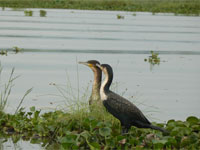
Top stories



LegalNigeria to implement new tax laws from January 1 despite calls for delay, Tinubu says
Camillus Eboh 20 hours

EducationChoosing a career? In a fast-changing job market, listen to your inner self – counsellor
Kobus Maree 19 hours


The Kenya Wetlands Atlas, produced with funding from the Government of Kenya and the Danish International Development Agency (DANIDA) and technical support from the UN Environment Programme (UNEP), details the many challenges facing dozens of important ecosystems.
In order to reverse the worrying trend of degradation, the atlas highlights the need for Kenya to embrace a raft of measures under the Ramsar Convention on Wetlands' main pillars of wise use, designating and managing more Wetlands of International Importance (Ramsar Sites), and international cooperation.
"The integrity of the country's water resources and agricultural productivity is sustained by our wetlands, which are nutrient rich and productive for most of the year," said Judi W. Wakhungu, Kenya's cabinet secretary for environment, water and natural resources.
"Despite their role in sustaining livelihoods we are seeing severe pressures. To combat this, the government has embarked on a long-term strategy to promote the protection of wetlands, in particular through a wetlands conservation and management policy currently under revision," said Wakhungu.
Another aspect of this strategy is the Master Plan for the Conservation and Sustainable Management of Water Catchment Areas in Kenya, also funded by DANIDA.
The plan recognises that persistent and intense cyclical droughts and floods are a proxy indicator of extensive environmental degradation. In view of this, the plan identifies water catchment pillars that require critical conservation and sustainable management.
Indeed, the plan identifies gaps and conflicts in current legislation and policies, and draws a roadmap for integrated planning that includes all stakeholders. The master plan provides a framework upon which recommendations in the Wetlands Atlas shall be implemented.
The Ramsar Convention on Wetlands has been in force in Kenya since 1990, and an environment-friendly Constitution was promulgated in 2010. The Environment Management and Coordination Act and its by-laws contain a number of innovative wetland provisions. In addition the government is in the process of introducing a holistic national environmental policy that deals with challenges facing wetlands including:
"The Millennium Ecosystem Assessment estimated that wetlands provide services worth US$15 trillion worldwide, including food, water, disaster regulation, climate regulation, and cultural and recreational values," said Achim Steiner, UN under-secretary-general and UNEP executive director.
"Yet wetlands including water catchment areas are being degraded and lost more rapidly than other ecosystems, largely because their functions are not always understood by governments or given enough weight in policy decisions," he added. "UNEP is therefore very pleased that Kenya recognises the value of its wetlands and their importance in attaining Vision 2030, and that it is implementing a long-term strategy to promote their sustainable management."
The atlas details many of Kenya's wetlands and the specific pressures facing them, including:
Lake Victoria North Basin Wetlands: Located to the north of Lake Victoria, the world's second-largest freshwater lake, these wetlands provide many services including fishing, farming and forestry. However, they face threats from inappropriate land use, mining, conversion of wetlands to agricultural use and unsustainable exploitation of resources.
For example, about 6,900 hectares in the Yala Swamp, part of the wetlands, have been leased to private companies for intensive agricultural activities, leading to water extraction and the flow of pesticides and fertilisers into the ecosystem.
Rift Valley Basin Wetlands: A 60-kilometre wide internal drainage basin, the Rift Valley hosts some of Kenya's most-iconic lakes, such as Lake Nakuru, Lake Naivasha, Lake Elementaita, Lake Baringo and Lake Turkana. Urbanisation, increasing demand for resources and other pressures have led to pollution, soil erosion and reduced quantity and quality of water.
For example, Lake Naivasha, designated as a Wetland of International Importance since 1995, has seen reducing water levels due in part to a massive increase in flower farms withdrawing water and a 50-fold increase in local population over the last three decades.
Mara River Basin: Shared between Kenya and Tanzania, this transboundary region hosts the Masai Mara and Serengeti national parks, whose wide variety of animals provides vital tourism income to both countries. The human population of the basin was estimated at 838,701 in 2010, and is clocking in an annual growth rate of around 3%. This growth is likely to outpace the wetland's capacity to provide ecosystem services. Land-use changes are already eroding important habitats.
Nairobi River Basin: Many of Nairobi's wetlands have already been lost due to the expansion of the city, drained to create space for shopping malls, buildings, roads, car parks and recreational facilities. Those that have survived are under pressure from subsistence farming, quarrying and dumping. As a result, the numbers of birds in and around the city are steadily declining, while virtually all the tributaries of the Nairobi River are polluted.
In order to achieve sustainable management of Kenya's wetlands and water catchment areas, the report calls for the urgent implementation of the three pillars of the Ramsar Convention - a move which would enhance the capacity of wetlands and water catchment areas to support human well-being and national development.
Specifically, the Atlas and the master plan bring to the fore a series of recommendations under the three pillars, including:
Wise Use
Wetlands of international importance
International cooperation
To download the Kenya Wetlands Atlas and the Master Plan for the Conservation and Sustainable Management of Water Catchment Areas in Kenya, go to www.unep.org.